Abstract
Natural hydraulic lime soil has good mechanical properties; as an earthen ruin restoration material, its durability is insufficient. Despite natural hydraulic lime being a topic that has been studied for several years from different researchers, it has not yet been fully considered for the improvement of durability. This work aims to experimentally investigate the enhancement of the durability properties of hydraulic lime-based. The performance of natural hydraulic limestone by adding sodium methyl silicate and organic silicon is examined and the effect of adding sodium methyl silicate on its performance and microstructure is studied. The 6%, 10%, and 15% lime–soil comparison test blocks of sodium silicate were compared with different lime–soil comparison test blocks not mixed with sodium methyl silicate; in addition to compression resistance, shear resistance, water absorption, and erosion resistance, dry–wet cycles were carried out, as well as microstructure testing and analysis. The results show that the addition of sodium methyl silicate enhances the compressive strength of hydraulic lime-modified soil, reduces its saturated water absorption, reduces its shear strength, improves its resistance to dry and wet cycles, and forms on the surface of the modified soil particles. The hydrophobic layer further improves its erosion resistance and water resistance. When the sodium methyl silicate content is 0.3%, the natural hydraulic lime soil has good mechanical properties and good durability, which is the optimal ratio.
1. Introduction
Natural hydraulic lime soil, especially natural hydraulic lime with less hydraulic components, is easily affected by external factors, such as carbonation [1], chemical corrosion [2], freeze–thaw cycles [3]; carbonation, chemical corrosion, and freeze–thaw cycles can cause insufficient durability. Most earthen ruins are in the open environment, and their soil is susceptible to acid rain and acidic substances from groundwater. Long-term exposure to the acidic environment will cause the destruction of the structure of the earthen ruins and seriously affect the stability of the earthen ruins [4]. If the performance of the repair materials is poor and the service life is not long, it may cause further damage to the earthen ruins [5]. Since the weathering damage mentioned above requires water as a medium [6], when designing the use of natural hydraulic lime soil as a restoration material, the durability of the natural hydraulic limestone is improved by adding sodium methyl silicate to extend its service life.
In recent years, in the restoration of earthen ruins, soil collapse repair projects have often been repaired by modified soil [7]. Tests have proved that organic-modified materials such as acrylic epoxy resin modified soil have a good effect on the restoration and reinforcement of earthen ruins, but due to easy yellowing, unsatisfactory aging resistance, insufficient durability, and aging products are not compatible with soil [8,9,10,11]. Therefore, the exploration direction of modified soil extends to inorganic materials. The chemical composition of inorganic materials is close to that of soil, and they are resistant to aging. At present, many domestic scholars have conducted research on the application of natural hydraulic lime modified soil and have achieved good experimental results. Peng Xiaoqin et al. [12] modified natural hydraulic lime by adding tung oil and calcium stearate. The study found that tung oil and calcium stearate can significantly improve the water resistance of natural hydraulic lime, but it will hinder the natural hydraulic lime. The water ash reaction reduces the strength of natural hydraulic lime to a certain extent. Chen Fanghong et al. [13] studied the influence of internally mixed waterproofing agent on hydraulic lime and carried out the compressive strength of hydraulic lime test block mixed with silicone waterproofing agent and hydraulic lime test block not mixed with waterproofing agents. By examining flexural strength, water absorption, and volume stability and conducting microstructure testing and analysis, the results show that silicone waterproofing agents will affect the progress of the carbonation of hydraulic lime. Xu Shuqiang et al. [14] compounded natural hydraulic lime by adding an isobutyltriethoxysilane organic modifier. The results showed that the use of inorganic-organic compound modification overcomes the shortcomings of using organic modifiers alone, and using a certain material ratio and compound modification improves the mechanical properties of natural hydraulic lime. Sodium methyl silicate, also known as organosilicon waterproof material, as a new type of rigid building waterproof material, has been widely used in internal and external walls, roof, waterproof and moisture-proof ground, as well as dams, bridges, tunnels, and other projects. Sodium methyl silicate also performed well in the test by inhibiting the water absorption rate of concrete. The test results show that the hydraulic gel material is represented by concrete. After adding sodium methyl silicate, the microstructure of the specimen is denser, thereby improving the macroscopic properties of concrete, including its waterproof and impermeable properties [15,16]. Studies have shown that sodium methyl silicate can improve the moisture resistance of microwave hardened sodium silicate sand [17,18]. Sodium methyl silicate has also been used to improve the performance of silt soil in the yellow flooding area and significantly improve the mechanical properties and impermeability of silt soil [19].
The need to preserve earthen sites has grown over the past decade. Indeed, because of the strict rules for the preservation of historic structures, conservation committees usually request structurally efficient but less intrusive techniques to protect the historical structures [20].
In summary, natural hydraulic lime can improve durability by adding organic waterproof materials, and sodium methyl silicate has an excellent performance in improving hydraulic gel materials. In this paper, the durability of hydraulic lime soil is improved by adding sodium methyl silicate, and the effect of sodium methyl silicate on its performance is studied, which provides a theoretical basis for the study of modified soil materials in the restoration and protection of earthen sites. Because the composite material has good mechanical properties and durability, it has wide application prospects in the restoration of soil sites and can be used to repair cracks, spalling, and other diseases of the walls of soil sites [21].
2. Materials and Methods
2.1. Materials
The soil for the experiment was taken from the surrounding area of the site. Natural hydraulic lime NHL2 comes from Shanghai Desaibao Building Materials Co., Ltd. (Shanghai, China). The place of production is Germany, the manufacturer is Hessler, and the main ingredients are shown in Table 1, soil physical and mechanical properties are shown in Table 2. Sodium methyl silicate is abbreviated as SMS, from Jinan Xingfeilong Chemical Co., Ltd. (Jinan, China).

Table 1.
The main chemical components of hydraulic lime (%).

Table 2.
Soil physical and mechanical properties.
2.2. Sample Preparation
In order to study the effect of sodium methyl silicate on the properties of natural hydraulic lime soil, the mass fraction of hydraulic lime ash was chosen to be 6%, 10%, and 15%, thus forming 3:7, 2:8, and 1:9 ash-soil, and then sodium methyl silicate with mass fractions of 0.1%, 0.3%, and 0.5% was mixed in these three different ash ratios. The mixing was carried out according to different ratios to produce 9 groups of specimens, and 3 groups of specimens without sodium methyl silicate were set as control groups.
Add natural hydraulic lime and sodium methyl silicate according to the ratio in Table 3. First, mix the natural hydraulic lime and soil evenly, pour in the sodium methyl silicate solution, and then add an appropriate amount of water and stir evenly. According to the specifications of the earthen site, a circular pie-shaped standard ring knife specimen of 61.8 mm × 20 mm was used; a 39.1 mm × 80 mm cylindrical specimen with a diameter of 39.1 mm and a height h of twice the diameter was produced for different tests. The method of force compaction prepares round cake-shaped specimens, and the voltage stabilization lasts for about 1 min; the cylindrical specimens are made by the layered compaction method. Put the demolded sample into a constant temperature and humidity box for curing, and the curing age is 28 days.

Table 3.
Test ratio design.
2.3. Compressive and Shear Test
In order to study the influence of different sodium methyl silicate content on the shear strength of natural hydraulic lime soil specimens, 0.1%, 0.3%, 0.5%, and 0.5% were added to 6%, 10%, and 15% natural hydraulic lime soil in sequence. With 0.7% sodium methyl silicate solution, a total of 12 groups of φ31.9 mm × 62.8 m cylindrical samples were made, and 3 groups of natural hydraulic lime soil samples without silicone waterproofing agent were set as the control groups. There are 2 samples in each group, and the preparation and maintenance of the test pieces are the same as described.
The influence of different content of sodium methyl silicate on the shear strength of natural hydraulic lime soil with different proportions was examined; 0.1% and 0.3% were added to the modified soil with 6%, 10%, and 15% natural hydraulic lime content in sequence: 0.5% and 0.7% sodium methyl silicate. A total of 12 sets of φ61.8 mm × 20 m standard ring knife samples were made, and 3 sets of natural hydraulic lime soil samples without an organic waterproofing agent were set as the control group. Four samples for each group were used for the production and maintenance of test pieces. The test method refers to the “Determination of water absorption by capillary action (CEN/TC 346)” and “Standard for Geotechnical Test Methods” [22].
2.4. Durability Test
After curing for 28 days, dry the surface of the test block and place it in a drying box with an interval of not less than 10 mm. After drying to a constant weight at a temperature of (110 ± 5) °C, it is cooled to room temperature and weighed in a dry state. Then, the test block is immersed in water, the distance between the test blocks is not less than 10 mm, and the upper end of the test block is more than 20 mm from the water surface. After about 12 h, the test block is taken out and its saturated water absorption rate is called. In order to test the influence of sodium methyl silicate on the dry–wet cycle resistance of natural hydraulic lime soil, a dry–wet cycle test was designed. The highest relative humidity of the test is set to 80%, and the lowest relative humidity is set to 38%. Put the cured specimens into the temperature and humidity control room; the horizontal and vertical spacing of the specimens is about 5 cm. Adjust the temperature and humidity control panel and set the temperature to a constant value; the average temperature is around 22 °C, and the relative humidity is controlled to change within a certain range. The upper and lower limits take the maximum and minimum values: 80% and 38%, respectively. The cycle sequence is shown in Figure 1. Set 12 h as a cycle, and the number of cycles is 20 and 40, respectively. The test is set with reference to the “Technical Specifications for the Protection of Earth Sites” [23].
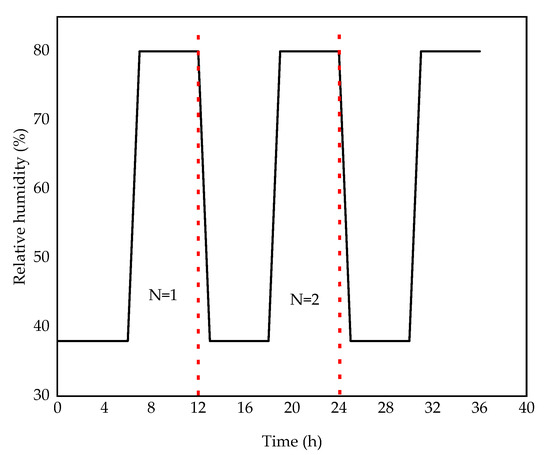
Figure 1.
Constant temperature dry and wet cycle sequence.
2.5. Anti-Scouring Test
In order to test the influence of sodium methyl silicate on the anti-scouring performance of natural hydraulic lime soil, an anti-scouring test was designed. During the test, the modified soil specimens need to be placed on the test bench one by one, and the spray device is used to spray the raw soil specimens. The nozzle is 50 cm away from the specimen, and the water pressure is controlled at 0.05- by adjusting the tap within the range of 0.09 MPa. During the test, observe the changes in the shape of the specimen at all times, and record the appearance of the specimen at intervals of 15 min, 30 min, and 60 min (Table 4). In order to better reflect the erosion effect of natural rainwater on the walls of the ruins, different working conditions were designed according to different rainfall, and the anti-scouring ability of the specimens under different working conditions was simulated. The test is based on “Technical Specifications for the Protection Test of Earth Sites” [23]. The working conditions are designed in this section, as shown in Table 4.

Table 4.
Anti-scouring test conditions.
2.6. Micro Test
To study the influence of sodium methyl silicate on the microstructure and performance of natural hydraulic lime soil, take one piece of natural hydraulic lime with 0.3% SMS and one piece of hydraulic lime soil without sodium methyl silicate, the content of sample components are shown in Table 5. The test block is cut in the middle, and a particle sample with a particle size of about 10 mm at the center is placed under a Sigma500 scanning electron microscope (ZEISS, Jena, Germany) for microscopic analysis. In order to better understand the pore structure and waterproof mechanism of lime soil mixed with sodium methyl silicate, a mercury intrusion test was carried out. Sample 1 is a modified soil sample mixed with sodium methyl silicate, sample 2 is a natural hydraulic lime soil sample, and sample 3 is a natural hydraulic lime soil sample mixed with sodium methyl silicate. The test standard refers to “Technical Specifications for Protection Test of Earth Sites” [23].

Table 5.
Sample ratio.
3. Test Results and Analysis
3.1. Compressive Strength Test and Discussion
Table 6 shows the unconfined compressive strength of the specimens with different proportions, and Figure 2 shows the compressive strength curve. From Table 4 and Figure 1, it can be seen that for 6% natural hydraulic lime soil, the increase in compressive strength ranges from 1.73% to 3.26%. When the sodium methyl silicate content is 0.3%, the strength of natural hydraulic lime soil reaches its peak value, and with the increase in sodium methyl silicate content, the compressive strength shows a downward trend; for 10% natural hydraulic lime soil, the compressive strength increase range is −0.29~2.95%, and the sodium methyl silicate content is observed. The strength of natural hydraulic lime soil reaches its peak value at 0.5%, and it shows a trend of increasing first and then decreasing; when 15% natural hydraulic lime soil is mixed with sodium methyl silicate, the compressive strength remains basically unchanged. In summary, the compressive strength of natural hydraulic lime is increased after adding sodium methyl silicate, but the increase is small, and with the increase in sodium methyl silicate, it shows a downward trend. When the sodium methyl silicate content is between 0.1% and 0.5%, the compressive strength will increase the most. In summary, adding sodium methyl silicate to hydraulic lime soil can improve its compressive strength.

Table 6.
Unconfined compressive strength of composite modified materials.
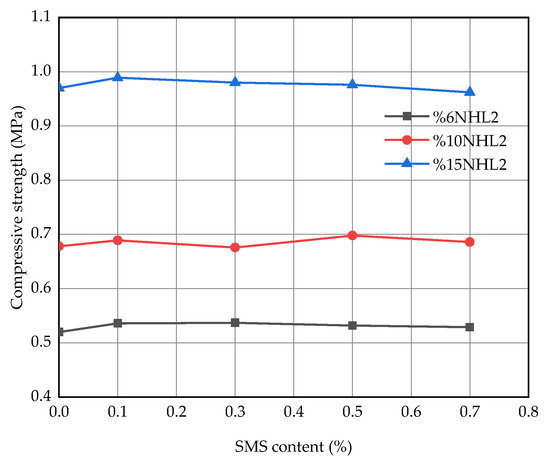
Figure 2.
Compressive strength change curve.
3.2. Shear Strength Testand Discussion
Figure 3, Figure 4, Figure 5, Figure 6, Figure 7 and Figure 8 show the changes in shear strength of composite modified soil with vertical pressure, cohesion, and internal friction angle with the content of sodium methyl silicate. It can be seen from Table 7 and Figure 2, Figure 3, Figure 4, Figure 5, Figure 6 and Figure 7 that the shear strength of natural hydraulic lime soil decreases to varying degrees after adding sodium methyl silicate solution. This is due to the addition of sodium methyl silicate in the curing process of natural hydraulic lime. The silicone waterproofing agent forms a barrier between water and natural hydraulic lime, which slows down the hardening process of natural hydraulic lime within the same period of time. The shear strength of composite modified soil is lower than that of natural hydraulic lime. Among them, the shear strength of composite modified soil mixed with 0.1% sodium methyl silicate decreased the least, and the shear strength of composite modified soil mixed with 0.5% sodium methyl silicate solution decreased the most. After adding 0.1%, 0.3%, and 0.5% sodium methyl silicate, the cohesive force of 6% natural hydraulic lime soil decreased by 5.10%, 9.60%, 12.11%, and 14.72%; the internal friction angle decreased by 1.22 %, 2.17%, 2.82%, and 3.14%. Ten percent natural hydraulic lime soil was mixed with 0.1%, 0.3%, 0.5%, and 0.7% sodium methyl silicate solution. The shear strength is reduced when mixed with 0.1% sodium methyl silicate solution. The shear strength of modified soil decreased the least; when 0.5% sodium methyl silicate solution was mixed, the shear strength of composite modified soil decreased the most. After adding different amounts of sodium methyl silicate solution, the cohesive force of 10% natural hydraulic lime soil decreased by 1.76%, 9.18%, 13.44%, and 17.49%, respectively; the internal friction angle decreased by 0.06%, 0.79 %, 1.35%, and 1.71%. The cohesion and internal friction angle decreased the most when the sodium methyl silicate solution was mixed with 0.7%. In summary, by analyzing the influence of different contents of sodium methyl silicate on the shear strength of modified soil with the same lime–soil ratio, under the condition that the proportion of hydraulic lime remains unchanged, it can be seen that, with the increase in the content of sodium methyl silicate solution, the shear resistance of natural hydraulic lime soil the strength continues to decrease and tends to stabilize. Among them, 0.3% sodium methyl silicate + 6% hydraulic lime soil has the smallest decrease.
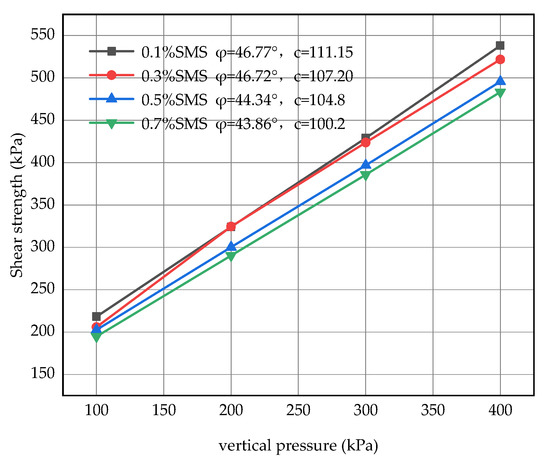
Figure 3.
The change of 6% NHL2 shear strength with vertical pressure.
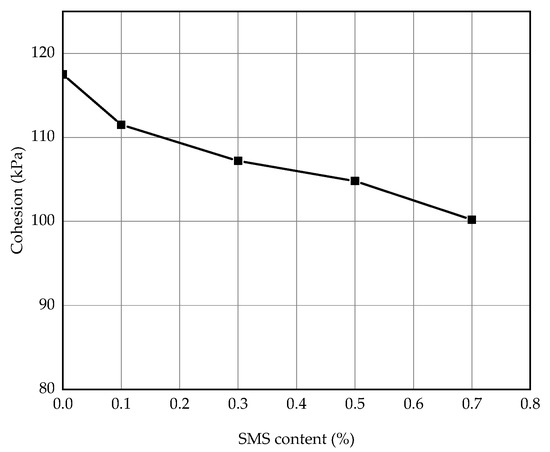
Figure 4.
Change of cohesion force with SMS content.
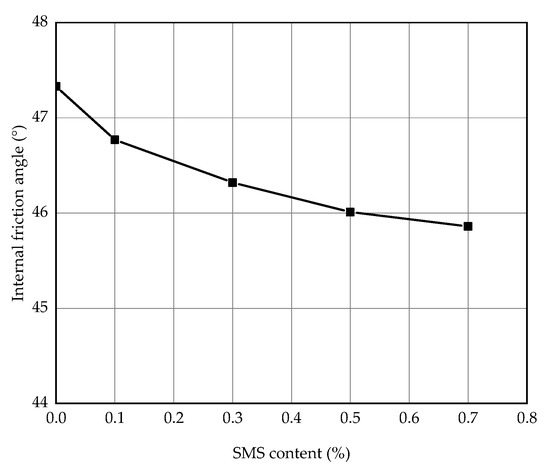
Figure 5.
Variation of internal friction angle with SMS content.

Figure 6.
Changes in shear strength of 10% NHL2 with vertical pressure.
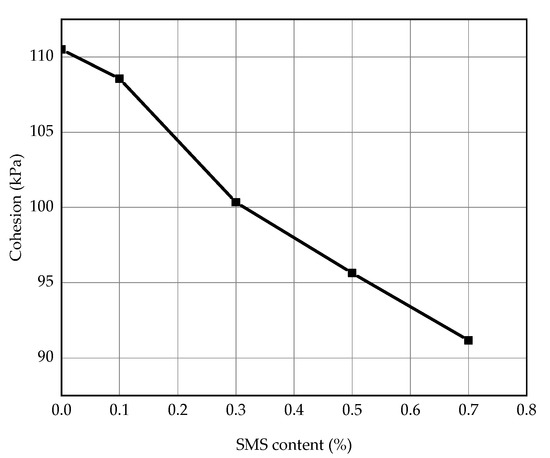
Figure 7.
The change of cohesion force with SMS content.
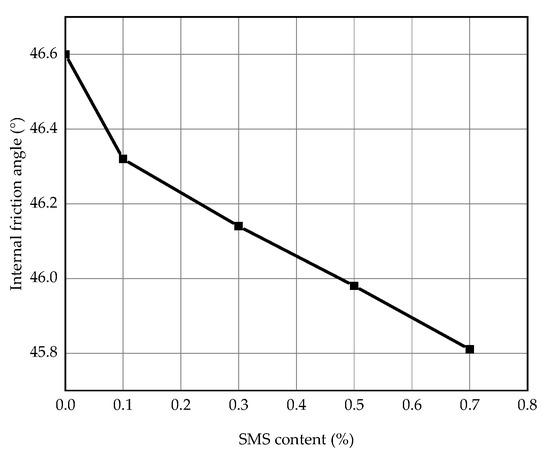
Figure 8.
Variation of internal friction angle with SMS content.

Table 7.
Cohesion and internal friction angle of composite modified materials.
3.3. Water Absorption Test and Discussion
Figure 9 shows the water absorption rate of natural hydraulic lime–sodium methyl silicate. It can be seen from Figure 9 that as the content of natural hydraulic lime increases, the water absorption rate of the composite modified soil increases mainly due to the increase in the ash content and the compactness of the rammed soil. The lowering of the degree of porosity leads to an increase in porosity; with the increase in the sodium methyl silicate content, the water absorption rate of the composite modified soil decreases, mainly because the addition of sodium methyl silicate inhibits the increase in capillary water of the specimen and slows down the specimen. Water absorption speed and a hydrophobic layer is formed on the surface of the soil particles of the specimen, which isolates part of the water. In summary, with the increase in sodium methyl silicate content, the water absorption of the composite modified soil decreased.
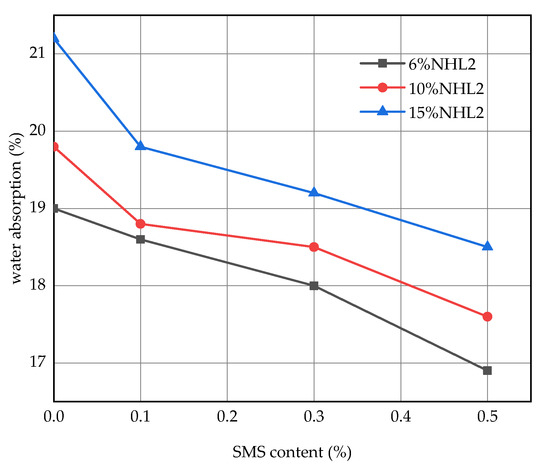
Figure 9.
NHL2-SMS water absorption curve.
3.4. Dry and Wet Cycle Test and Discussion
Table 8 and Table 9 are the test data of dry–wet cycle and the apparent phenomena of the specimens. It can be seen from Table 8 and Table 9 that the surface of natural hydraulic lime soil is powdered after 20 dry–wet cycles, and after 40 dry–wet cycles, the surface is powdered, with a little shedding around it, and fine cracks appear on the surface. After adding sodium methyl silicate, the natural hydraulic lime soil has no dry cracking, peeling, cracking, pulverization, etc., after 20 to 40 cycles of dry and wet cycles. Moreover, the volume change rate is reduced to a certain extent compared with the sample without sodium methyl silicate. In summary, sodium methyl silicate can effectively improve the dry–wet cycle resistance of natural hydraulic lime soil and the volume stability under dry–wet cycle conditions.

Table 8.
Dry and wet cycle test.

Table 9.
Apparent phenomena of dry and wet cycle test.
3.5. Anti-Scouring Testand Discussion
It can be observed from Figure 10 and Figure 11 that the hydraulic lime soil mixed with sodium methyl silicate did not show obvious damage at the beginning of the test, water droplets were attached to the surface of the test piece, and the water was not absorbed. Cut the inside of the specimen and measure the internal humidity of the specimen; the inside is still dry soil, indicating that sodium methyl silicate has a significant waterproof effect and can prevent water from entering the soil. By comparison, it can be found that, during the scouring process, the natural hydraulic lime soil not mixed with sodium methyl silicate has no water droplets attached to the surface, and the water is quickly absorbed. Due to the water pressure, the surface of the soil is easily damaged, and the surface of the specimen will be formed. The uneven rough surface increases the effect of water pressure, and the surface is easily damaged and the soil is lost in the subsequent scouring. The surface of natural hydraulic lime soil mixed with sodium methyl silicate remains basically intact without obvious defects. In summary, sodium methyl silicate can improve the erosion resistance of natural hydraulic lime soil to a certain extent.
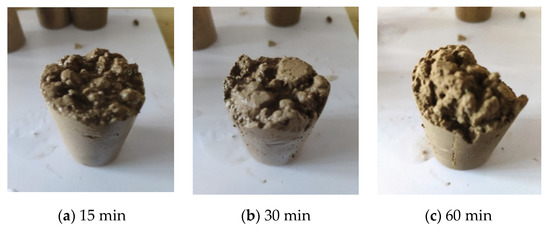
Figure 10.
The change of 6% NHL2 hydraulic lime soil with time.
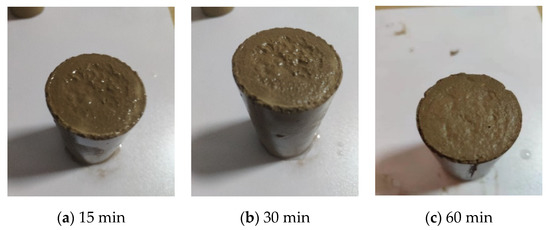
Figure 11.
The change of 6% NHL2–0.1% SMS hydraulic lime soil with time.
3.6. Scanning Electron Microscope Testand Discussion
Figure 12a is a typical SEM image of silt. It can be seen that the skeleton of the silt is dominated by sand particles, the surface of the particles is rough, there are obvious edges and corners, and the gap between the particles is large, which belongs to the granular structure. The contact mode is mainly point or surface contact, and there are obvious boundaries between the skeleton units; the pores are irregular in shape, and there is basically no filler in the pores. Figure 12b is the SEM image of the modified soil with only sodium methyl silicate water repellant. Compared with the SEM microstructure of the silt soil, the surface of the soil particles becomes relatively smooth, and the contact mode between the particles is mainly surface contact. The contact area is large, the pore size is relatively reduced, the number of pore sizes is relatively reduced, there are obvious boundaries between the framework units, and the pores are still overhead pores, but there are a small amount of fillers in the pores. When the sodium methyl silicate solution penetrates into the soil, it reacts with water and carbon dioxide, decomposes into methyl silicic acid and rapidly forms a polymethylsiloxane film covering the soil surface, causing the surface of soil particles to form a layer of waterproof membrane attached between the particles, which changes the connection mode between the particles, increases the contact area between the particles, and reduces the channel required for water circulation, which is also the ability of sodium methyl silicate-modified soil to become waterproof. The main chemical reactions are as follows.
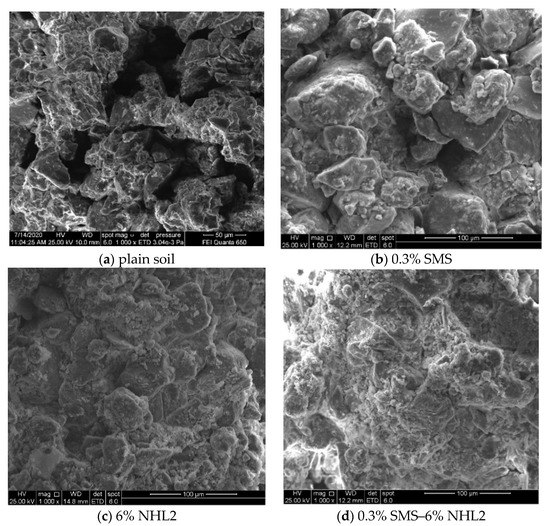
Figure 12.
Photo of microstructure with different additives.
Figure 12c is the SEM image of natural hydraulic lime soil. It can be seen that the surface of natural hydraulic lime soil particles is rough and has obvious edges and corners, and the particles are closely connected, and the contact mode is mainly surface contact. There is no obvious boundary, and the unit structure is dense. There are a lot of fillers in the soil pores, the overhead voids are greatly reduced, and irregular calcium carbonate is attached to the soil surface. The main chemical reactions are as follows.
It can be seen from Figure 12c that the microstructure of the test block without sodium methyl silicate is relatively loose and mostly granular or contains irregularly shaped calcium carbonate, indicating that water and carbon dioxide are easily in contact with natural hydraulic lime, which in turn makes the reaction of calcium hydroxide with carbon dioxide and water more sufficient, producing a series of carbonation products such as calcium carbonate. From Figure 12d, it can be seen that the microstructure of the test block doped with 0.3% water that the repellent is relatively dense, and some calcium hydroxide that has not undergone carbonation reaction is distributed on the surface of the sample, indicating that methyl silicon Sodium forms a barrier between water and natural hydraulic lime, which hinders the interaction between water and natural hydraulic lime, resulting in a denser sample surface. The compact microstructure of natural hydraulic lime soil is the reason why it is difficult for outside water to enter, and it is also an important reason for its low saturated water absorption rate and increased strength.
3.7. Mercury Intrusion Testand Discussion
It can be seen from Table 10 that the porosity of natural hydraulic lime is significantly increased after adding natural hydraulic lime, indicating that natural hydraulic lime will increase the porosity of the soil and reduce the compactness of the soil. Figure 13, Figure 14 and Figure 15 show the changes in mercury injection–mercury removal curve with different soil sample. Adding sodium methyl silicate waterproofing agent solution will reduce the porosity of the soil and increase the compactness of the soil. For sample 1, it is obvious that large pores with a diameter larger than 10 μm has an absolute advantage; for sample 2, similarly to sample 1, large pores with a diameter larger than 10 μm have an absolute advantage, but compared with sample 1, large pores are less small and mesopores and micropores increase, indicating that the proportion of large pores in the soil decreases when natural hydraulic lime is added. The proportion of medium and micropores increases; for sample 3, similarly to the first two, large pores have a diameter greater than 10 μm. It has an absolute advantage, but the difference is that compared with sample 2, the proportion of large pores in sample 3 is reduced, and the proportion of medium, small, and micro pores increased, indicating that the addition of sodium methyl silicate waterproofing agent solution will reduce the soil’s mass. The proportion of large pores can increase the proportion of medium, small, and micro pores in the soil. Figure 16, Figure 17 and Figure 18 show the changes in Pore size distribution density curve with different soil sample. In summary, the addition of natural hydraulic lime increases the soil’s porosity and decreases the compactness. The waterproof performance of soil mainly depends on the proportion of mesopores and macropores in the soil. After adding sodium methyl silicate, the porosity of natural hydraulic lime soil decreases, the density increases, and the proportion of macropores decreases. The proportion of mesopores and small pores increased, indicating that the addition of sodium methyl silicate waterproofing agent can effectively enhance the waterproof performance of natural stone hard lime soil, thereby improving its durability.

Table 10.
Pore structure characteristic parameters of mercury intrusion test.
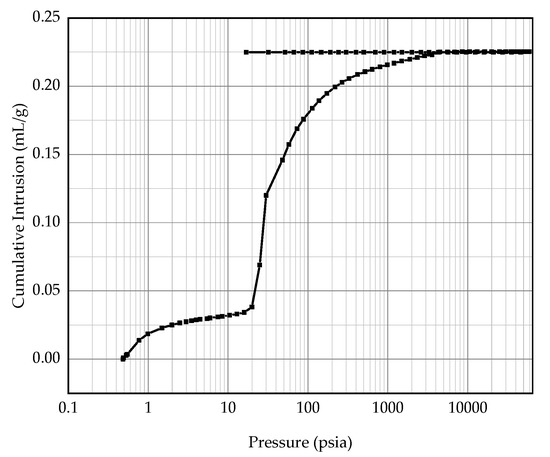
Figure 13.
Mercury injection–mercury removal curve of soil sample 1.
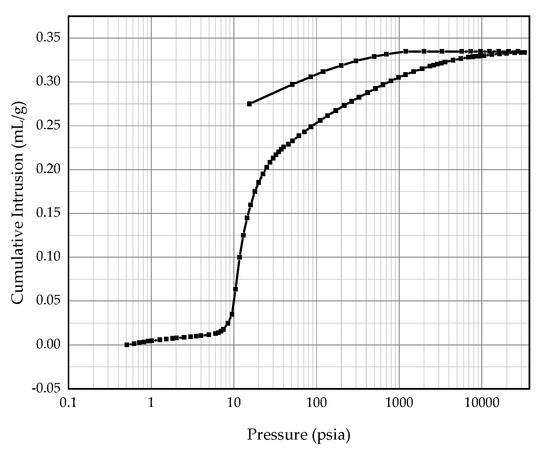
Figure 14.
Mercury injection−mercury removal curve of soil sample 2.
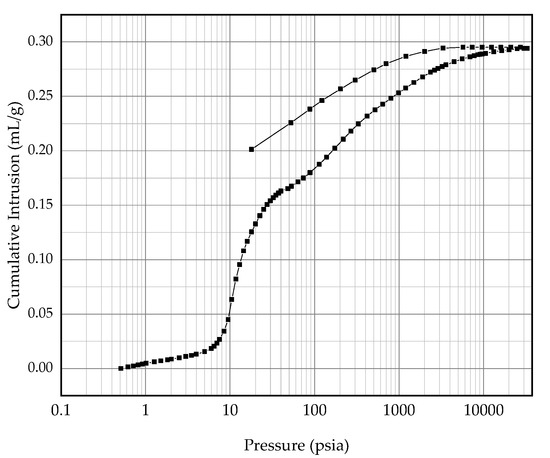
Figure 15.
Three mercury injection–mercury removal curve of soil sample.

Figure 16.
Pore size distribution density curve of soil sample 1.
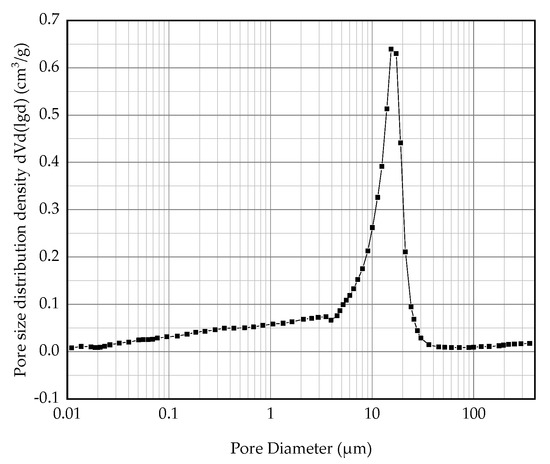
Figure 17.
Pore size distribution density curve of soil sample 2.
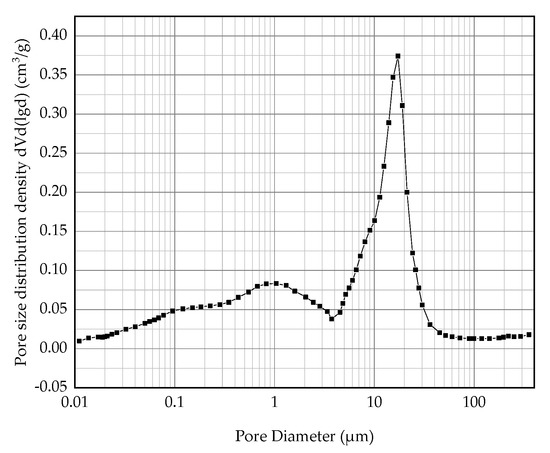
Figure 18.
Pore size distribution density curve of soil sample 3.
4. Conclusions
(1) Sodium methyl silicate has a certain enhancement effect on the compressive strength of natural hydraulic lime soil, and the average increase in 28d compressive strength is about 2.8%, and as the lime–soil ratio increases, the enhancement decreases. To a certain extent, the internal friction angle and shear strength of natural hydraulic lime soil are reduced. The average decrease in internal friction angle and shear strength of 28d is about 2.6% and 10.4%, and as the lime–soil ratio increases, the decrease increases largely. When it is finally determined that soil + 6% and natural hydraulic lime + 0.3% sodium methyl silicate are present, the repair material has good mechanical properties.
(2) Sodium methyl silicate can effectively improve the water resistance, scour resistance, water immersion shear resistance, and dry–wet cycle resistance of natural hydraulic lime soil; at the same time, it can effectively reduce the water absorption rate of natural hydraulic lime soil. Studies have shown that when the content of sodium methyl silicate is 0.3% to 0.5%, and durability performance is improved the most. While improving the durability of natural hydraulic lime soil, sodium methyl silicate reduces its shear strength to a certain extent. The compressive strength of composite-modified soil is slightly improved. When the content of natural hydraulic lime is 6~10% and the content of sodium methyl silicate is 0.3~0.5%, the composite modified soil repair material has good water resistance, erosion resistance, dry and wet cycle resistance, and has good compressive and shear strength. After comprehensive considerations, it is finally determined that soil + 6% natural hydraulic lime + 0.3% sodium methyl silicate is the best ratio. Therefore, the composite material of this ratio has broad application prospects in the restoration of soil sites. In particular, it has good advantages in repairing cracks in soil sites or spalling of walls on the surface of sites. It can repair cracks in walls or spalling of walls in soil sites by masonry or grouting. Moreover, because of its excellent durability, it can delay the aging of the repaired wall.
(3) Microscopic tests show that a certain proportion of sodium methyl silicate water repellant is mixed into the natural hydraulic lime modified soil, which will form a waterproof film on the surface of the modified soil particles and between the units, which can effectively prevent water from entering and achieve waterproofing effect, thereby improving the durability of natural hydraulic lime soil. At the same time, the addition of sodium methyl silicate will make the surface of soil particles smooth, and the shear strength of the composite modified material will decrease. The addition of sodium methyl silicate will reduce the proportion of large pores in natural hydraulic lime soil, while the proportion of hollow and small pores will increase, effectively inhibiting the increase in soil capillary water. Sodium methyl silicate forms a barrier between water and natural hydraulic lime, preventing or slowing the entry of water into the soil. Therefore, the carbonization reaction between water and natural hydraulic lime is slowed down so that a small amount of calcium hydroxide remains on the surface of the modified soil, and the modified soil is more compact. In addition, sodium methyl silicate can hinder the reaction of calcium hydroxide and carbon dioxide in the modified soil, thereby delaying the carbonization of the material, improving its durability, and delaying the aging of its hydraulic lime soil surface.
Author Contributions
Conceptualization, Q.M.; methodology, Q.L.; validation, Q.L. and K.C.; formal analysis, S.L.; investigation, Q.L.; resources, S.L.; data curation, Q.L.; writing—original draft preparation, Q.L.; writing—review and editing, K.C.; visualization, S.L.; supervision, Q.M.; project administration, Q.M.; funding acquisition, Q.M. All authors have read and agreed to the published version of the manuscript.
Funding
This research was funded by Study on the formation mechanism and control measures of typical diseases in urban archaeological exploration, Project No. 212102310947.
Institutional Review Board Statement
This research not involving humans or animals.
Informed Consent Statement
This research not involving humans.
Data Availability Statement
The detailed information of the data is stored in the school of hydraulic science and engineering, Zhengzhou University.
Conflicts of Interest
The authors declare no conflict of interest.
References
- Barr, S.; McCarter, W.J.; Suryanto, B. Bond-strength performance of hydraulic lime and natural cement mortared sandstone masonry. Constr. Build. Mater. 2015, 84, 128–135. [Google Scholar] [CrossRef]
- Zhang, D.; Zhao, J.; Wang, D.; Xu, C.; Zhai, M.; Ma, X. CoMParative study on the properties of three hydraulic lime mortar systems: Natural hydraulic lime mortar, cement-aerial lime-based mortar and slag-aerial lime -based mortar. Constr. Build. Mater. 2018, 186, 42–52. [Google Scholar] [CrossRef]
- Xu, F.; Yang, J.; Yang, Y. Research on weatherability of hydraulic lime as a reinforcement material for rock paintings in Helankou. Sci. Cult. Relics Conserv. Archaeol. 2016, 28, 31–39. [Google Scholar]
- Liu, L.; Zhang, Z.; Xue, Q.; Fan, B.; Liu, Z. A preliminary study on the weathering mechanism and protection of ancient cultural sites. Wenbo 1988, 11, 71–75. [Google Scholar]
- Yuan, C. A summary of earthen ruins protection materials. Dunhuang Stud. 2002, 24, 103–105. [Google Scholar]
- Yang, Q.; Li, C. Experimental study on the influence of capillary water drying and wetting cycles on the weathering of earthen ruins. Chin. J. Undergr. Space Eng. 2012, 8, 517–525. [Google Scholar]
- Sun, M. Research status and progress of earthen ruins protection. Sci. Cult. Relics Conserv. Archaeol. 2007, 48, 64–70. [Google Scholar]
- Li, X.; Lin, J.; Wan, T.; Xiao, W. Preparation of a new type of soil site reinforcement material and evaluation of reinforcement effect. J. Chengdu Univ. Technol. (Nat. Sci. Ed.) 2006, 53, 321–326. [Google Scholar]
- Li, X. Preparation, Characterization and Application of New Earthen Site Protection Materials. Ph.D. Thesis, Chengdu University of Technology, Chengdu, China, 2007. [Google Scholar]
- Xiao, W.; Lin, J.; Wan, T.; Li, X. Study on the light transmittance and weather resistance of silicone modified acrylic epoxy resin. Guangdong Trace Elem. Sci. 2006, 16, 57–60. [Google Scholar]
- Li, X.; Wan, T.; Lin, J.; Xiao, W. Research on the preparation and performance of reinforcement materials for the Jinsha Earth Site. Mater. Sci. Technol. 2009, 17, 215–220. [Google Scholar]
- Peng, X.; Cao, C.; Ji, X.; Zeng, L. The effect of waterproofing agent on the performance of lime-metakaolin repair mortar. J. Hunan Univ. (Nat. Sci. Ed.) 2016, 43, 83–88. [Google Scholar]
- Chen, F.; Li, Q.; Ye, L. Research on the effect of internally mixed waterproofing agent on the properties of modified hydraulic lime in the restoration of ancient buildings. New Build. Mater. 2017, 44, 113–115. [Google Scholar]
- Xu, S. Study on the Organic/Inorganic Composite Modification of Natural Hydraulic Lime Used in the Restoration of Cultural Relics. Ph.D. Thesis, University of Science and Technology Beijing, Beijing, China, 2020. [Google Scholar]
- Guo, Z.; Zhu, Q.; Liu, C.; Xing, Z. Preparation of Ca-Al-Fe deicing salt and modified with sodium methyl silicate for reducing the influence of concrete structure. Constr. Build. Mater. 2018, 172, 263–271. [Google Scholar] [CrossRef]
- Liu, G. Experimental Study on Adding Chloride Ion Transport Retarding Materials to Cement Concrete. Ph.D. Thesis, Chang’an University, Xi’an, China, 2017. [Google Scholar]
- Shafran, A.W.; Gross, A.; Ronen, Z.; Weisbrod, N.; Adar, E. Effects of surfactants originating from reuse of greywater on capillary rise in the soil. Water Sci. Technol. 2005, 52, 157–166. [Google Scholar] [CrossRef]
- Dong, J.; Xu, H.; Zhu, D.; Zhu, H. Experimental study on polymer material modified silt in different water environments. Chin. J. Geotech. Eng. 2013, 35, 1316–1322. [Google Scholar]
- Yuan, Y.; Jia, M.; Li, W. Experimental study on the stabilization of silt soil in yellow flooded area by sodium methyl silicate. Chin. Sci. Technol. Pap. 2017, 12, 831–833. [Google Scholar]
- Angiolilli, M.; Gregori, A.; Vailati, M. Lime-Based Mortar Reinforced by Randomly Oriented Short Fibers for the Retrofitting of the Historical Masonry Structure. Materials 2020, 13, 3462. [Google Scholar] [CrossRef] [PubMed]
- Vailati, M.; Mercuri, M.; Angiolilli, M.; Gregori, A. Natural-Fibrous Lime-Based Mortar for the Rapid Retrofitting of Heritage Masonry Buildings. Fibers 2021, 9, 68. [Google Scholar] [CrossRef]
- GB/T 50123-1999; Standard for Geotechnical Test Methods. Ministry of Water Resources of the People’s Republic of China: Beijing, China, 2006.
- WW/T 0039-2012; Technical Specification for the Protection Experiment of Earthen Ruins. State Administration of Cultural Relics of the People’s Republic of China: Beijing, China, 2012.
Publisher’s Note: MDPI stays neutral with regard to jurisdictional claims in published maps and institutional affiliations. |
© 2022 by the authors. Licensee MDPI, Basel, Switzerland. This article is an open access article distributed under the terms and conditions of the Creative Commons Attribution (CC BY) license (https://creativecommons.org/licenses/by/4.0/).